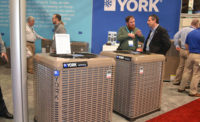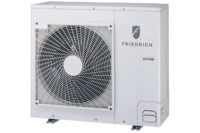The HVAC industry is often coined as “recession-proof” because the demand for indoor comfort is not going away. In fact, it’s growing. The global market for air conditioning systems was pegged at a value of $104.4 billion in 2015 and is projected to rise to $167 billion by the end of 2024, expanding at a 5.1 percent compound annual growth rate (CAGR) from 2016 to 2024, according to a report from Transparency Market Research.
And though central air conditioning and heating systems still dominate the U.S. market, ductless and variable refrigerant flow (VRF) technology has shown double-digit sales increases in the United States every year for the past five years.
“The most profound trend impacting the air conditioning segment is the increasing adoption of the ductless and VRF categories,” says Todd Nolte, cooling products manager, Carrier Corp. “Carrier has experienced strong organic growth in this segment in the past several years, and we continue to make investments at all levels of the channel to facilitate continued growth. This is exciting because it gives our dealers and distributors new revenue opportunities and provides our customers with greater flexibility and efficiency options. Growth in the ductless and VRF segment is rapid compared to incremental growth in years past. It feels as if the tide has turned in this segment and a once-niche product is going mainstream, which could signal a major shift in the way our channel goes to market.”
Such growth is evidenced by a recent report from MarketsandMarkets, which notes the global VRF market is projected to reach approximately $9.65 billion by 2021, registering a CAGR of 10.8 percent between 2016 and 2021.
Carrier recently introduced a new portfolio of VRF products at the 2017 AHR Expo in January.
“The new portfolio provides tremendous opportunity to shift the way commercial buildings are designed with less space required for ducts and the way luxury homebuilders think about climate control,” Nolte says. “Carrier is investing heavily in smart technologies that will better connect dealers and their customers, and that will create a more convenient and seamless user experience. Products like our expanded lineup of Cor thermostats exemplify this investment in their ability to create a more convenient, app-driven customer experience. This, combined with the investment in ductless and variable-speed products, will translate into systems that differ greatly from what dealers were installing a decade ago. This will present challenges to our channel in terms of changing sales techniques and training its workforce, but it will also present a wealth of opportunities to sell higher-end systems and accessories.”
According to Nolte, the rising impact of younger, more tech-savvy consumers and their passion for the environment and sustainability will translate into the adoption of more energy-efficient systems, which offer greater margin for dealers and distributors.
“The growth of the ductless segment is a huge opportunity for wholesalers to grow and evolve their relationship with contractors and to take a leading position in their individual segments,” he says. “From a regulatory perspective, most of the burden falls on the OEMs. However, the wholesalers must stay educated on the evolving landscape so they can educate their customers about the why and the how of this changing environment.”
Increased Comfort
Another trend driving the air conditioning market is consumers’ demand for increased comfort and energy efficiency.
“We continue to see a shift to modulation in the higher SEER segments of air conditioning markets for residential, and higher part load efficiency in commercial applications,” says Joe Linsenmeyer, director of marketing, residential air conditioning for Emerson’s Commercial and Residential Solutions platform. “Depending on the application, we are seeing growth in two-stage modulation and variable speed products. This trend has been consistent over the last several years in residential with two-stage growth primarily in the 16-18 SEER range and variable speed in 18+ SEER products. For commercial, IEER and efficiency are of increasing importance, with the Department of Energy rooftop air conditioner standards coming in 2018.”
Linsenmeyer notes that modulation provides better humidity control and comfort than fixed speed and is a great way to add value to customers while increasing sales.
Smarter Products
The biggest trend impacting the air conditioning market is the demand for smarter, connected products, according to Ken Ely, product manager, Unitary Products Group, Johnson Controls Inc.
“It’s no longer enough for an air conditioning system to cool a home,” Ely says. “Tech-savvy homeowners today want a system that can communicate with them, wherever they are, and deliver comfort efficiently, quietly, and reliably in a way that suits their active lifestyles. Homeowners are also more knowledgeable. Access to the internet enables them to research HVAC systems and identify the features and benefits that are important to them, long before they contact a contractor. Additionally, social media provides first hand reviews of equipment and contractors, which will likely influence homeowner buying decisions. As a result, new air conditioning systems feature things like modulating, variable-capacity technology that more precisely matches conditions, smart thermostats, service alerts, higher SEER ratings, and technologies that ensure quiet operation, cooling that adjusts to the climate, and advanced charge monitoring.”
Ely says manufacturers would continue to innovate, with the strongest advances in h connectivity, optimizing performance, and remote monitoring capabilities.
“Wholesalers need to do their own research, so they are well aware of the demands expressed by today’s homeowners,” he says. “They can no longer expect to deliver one system — the one that best meets their needs for profitability and servicing. Instead, they need to carefully read about and listen to homeowners, so they are prepared to provide systems that deliver on homeowners’ wish lists.”
Matt Barga, portfolio leader, Air Conditioners, Furnaces and Coils, Trane, says he is seeing several major market trends, including connected controls, better-educated consumers and a growing market for ductless systems.
“Connected controls are growing at a fast pace, enabling homeowners greater control and the ability to better optimize system performance overall,” Barga says. “Connected controls also give dealers the ability to remotely monitor and diagnose system performance, through Nexia Dealer Diagnostics, for example, providing peace of mind for the homeowner. Dealers can identify potential problems and alert homeowners before major issues arise. When it comes to connectivity and how it has changed from previous years, we see increased adoption and greater comfort with connected technology overall.”
Barga notes that consumers today are more driven by comfort.
“It’s not always just about the price anymore,” he says. “While consumers have historically based purchase decisions on price and efficiency, today’s better-educated consumers place greater importance on comfort. Today’s more knowledgeable consumers are more in tune with options and benefits such as variable speed, temperature consistency, humidity control, reduced sound and indoor air quality.”
Wholesalers should monitor these market trends and be prepared, Barga says.
“The trend toward digital, which is driving both online consumer research and connected controls options, is modifying how consumers make purchase decisions,” he explains. “As a result, the historical weight of advertising, selling and maintaining relationships with customers is different. Wholesalers need to be prepared to evolve their business models to keep pace with these changes. Distributors want to prepare themselves and their dealers to continue to effectively capture the consumer’s attention.
“In general, wholesalers need to be ready to evolve as consumers choose and evaluate their options in new and different ways,” Barga says. “When it comes to comfort, wholesalers need to recognize that comfort no longer represents only a premium solution for consumers; it’s part of the consumer’s basic level of expectations today. More and more, consumers want and expect comfort options at various price points. We will see these trends continue; digital growth will continue and even accelerate. Distributors and dealers need to remain nimble and responsive so that the growth of digital doesn’t lead to disruption in the marketplace with other suppliers filling unmet needs.”
Nicole Krawcke is the business management editor for The News. Contact Nicole at 248-244-6475 or nicolekrawcke@achrnews.com.










Report Abusive Comment